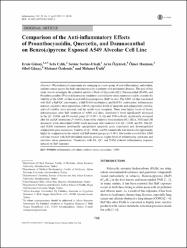| dc.contributor.author | Günay, Ersin | |
| dc.contributor.author | Çelik, Sefa | |
| dc.contributor.author | Sarınç-Ulaşlı, Sevinç | |
| dc.contributor.author | Özyürek, Arzu | |
| dc.contributor.author | Hazman, Ömer | |
| dc.contributor.author | Günay, Sibel | |
| dc.contributor.author | Ünlü, Mehmet | |
| dc.contributor.author | Özdemir, Mehmet | |
| dc.date.accessioned | 2020-11-20T15:02:35Z | |
| dc.date.available | 2020-11-20T15:02:35Z | |
| dc.date.issued | 2016 | |
| dc.identifier.issn | 0360-3997 | |
| dc.identifier.issn | 1573-2576 | |
| dc.identifier.uri | https://doi.org/10.1007/s10753-015-0301-3 | |
| dc.identifier.uri | https://hdl.handle.net/20.500.12809/2545 | |
| dc.description | WOS: 000374103000028 | en_US |
| dc.description | PubMed ID: 26747272 | en_US |
| dc.description.abstract | Phytochemical compounds are emerging as a new group of anti-inflammatory, antioxidant, and anti-cancer agents that help minimize toxicity in patients with pulmonary diseases. The goal of this study was to investigate the potential curative effects of Quercetin (QC), Damnacanthal (DAM), and Proanthocyanidine (PA) on inflammatory mediators and oxidative stress parameters and to examine the viability of the A549 cell line treated with benzo(a)pyrene (BaP) in vitro. The A549 cell line was treated with BaP, a BaP/QC combination, a BaP/DAM combination, and BaP/PA combination. Inflammatory markers, oxidative stress parameters, mRNA expression levels of apoptotic and antiapoptotic proteins, and cell viability were assessed, and the results were compared. There were higher levels of lactate dehydrogenase after BaP treatment of A549 cell lines. Interferon-gamma level significantly decreased in the QC, DAM, and PA-treated group (P < 0.001). IL-1 beta and TNF-alpha levels significantly decreased after PA and QC treatments (P < 0.001). Some of the oxidative stress markers (NO, MDA, TOS) and OSI decreased, while antioxidant (GSH) levels increased after treatment with QC, DAM, and PA. The QC and DAM treatments profoundly upregulated apoptotic gene expression and downregulated antiapoptotic gene expression. Viability of QC, DAM, and PA-treated cells was found to be significantly higher in comparison to the control and BaP-treated groups (p < 0.001). Our results revealed that A549 cell lines treated with BaP-stimulated necrosis produced higher level of inflammatory cytokines and oxidative stress parameters. Treatments with PA, QC, and DAM reduced inflammatory response induced by BaP exposure. | en_US |
| dc.description.sponsorship | Kocatepe University Scientific Research Council, Afyonkarahisar, Turkey [12.TIP.01] | en_US |
| dc.description.sponsorship | This project was supported by a grant from Kocatepe University Scientific Research Council, Afyonkarahisar, Turkey: Project number: 12.TIP.01. | en_US |
| dc.item-language.iso | eng | en_US |
| dc.publisher | Springer/Plenum Publishers | en_US |
| dc.item-rights | info:eu-repo/semantics/openAccess | en_US |
| dc.subject | Inflammation | en_US |
| dc.subject | Cell Culture | en_US |
| dc.subject | Oxidative Stress | en_US |
| dc.subject | Antioxidants | en_US |
| dc.subject | COPD | en_US |
| dc.title | Comparison of the Anti-inflammatory Effects of Proanthocyanidin, Quercetin, and Damnacanthal on Benzo(a)pyrene Exposed A549 Alveolar Cell Line | en_US |
| dc.item-type | article | en_US |
| dc.contributor.department | MÜ, Fethiye Sağlık Bilimleri Fakültesi, Beslenme ve Diyetetik Bölümü. | en_US |
| dc.contributor.institutionauthor | Özdemir, Mehmet | |
| dc.identifier.doi | 10.1007/s10753-015-0301-3 | |
| dc.identifier.volume | 39 | en_US |
| dc.identifier.issue | 2 | en_US |
| dc.identifier.startpage | 744 | en_US |
| dc.identifier.endpage | 751 | en_US |
| dc.relation.journal | Inflammation | en_US |
| dc.relation.publicationcategory | Makale - Uluslararası Hakemli Dergi - Kurum Öğretim Elemanı | en_US |


















